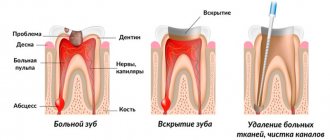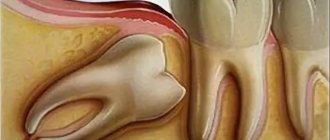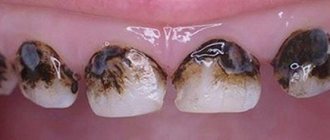Sometimes, after dental treatment, patients go to the dental clinic with a complaint of pain, not knowing that pain after some dental procedures is a normal phenomenon, and only in rare cases does it serve as a warning sign.
What causes pain after dental treatment and what to do in this situation?
Pain after caries treatment
Shallow caries
- After treatment of shallow caries, patients sometimes feel mild pain for several hours; in rare cases, pain can persist for 1-2 weeks. Unpleasant sensations may be aggravated by exposure to cold or hot food, or when biting or pressing on a tooth. The reason is as follows.
After removing the affected tissue from the carious cavity, its walls are treated with a special composition that improves the adhesion of the filling to the tooth. Before applying this composition, the cavity must be dried to a certain extent. If overdrying occurs, the nerve endings in the surface layer of dentin are irritated, which leads to pain. Over time, the dry tissues receive the necessary moisture from the tooth, and the pain disappears.
- The second reason for the occurrence of pain after treatment of superficial caries is the placement of a filling in the cervical part of the tooth, as a result of which the gums or interdental papilla are injured during the dentist’s work. Characterized by a nagging pain, slightly increasing when biting and exposure to cold food. Within a few days, the injured tissues heal, the pain disappears without a trace.
Deep caries
- After treatment of deep caries, pain may occur after the anesthesia wears off (an hour or two after treatment); if a piece of hard food gets on the tooth or if you run a toothpick over the filling. The tooth may also react to cold food: a mild pain occurs that disappears within a few seconds after the irritant ceases.
This is a normal phenomenon and is explained by the fact that the carious cavity was located close to the nerve fibers inside the tooth, and pressure is transmitted to them through the placed filling material. Gradually, the pain decreases and disappears, as a protective layer of dentin forms above the pulp, which separates it from the filling. This is a long process, so discomfort may persist for several months.
- Another reason for pain after tooth treatment may be overheating. This problem is relevant in clinics (usually budget ones) that are not sufficiently equipped with modern equipment, when the area of the tooth is not properly cooled during treatment with a drill. Because of this, hard tissues overheat, which leads to burns of the pulp and pain under the filling.
Mechanism of caries development
Caries, according to experts, is the most common disease in the world, occurring in more than 90% of the world's population. Despite this, many people have only a superficial knowledge of tooth decay. Therefore, questions often arise about possible symptoms of the disease, in particular, whether the temperature can rise with caries. To understand, let’s first consider what the carious process is. Essentially, this is the slow destruction of a tooth under the influence of various factors, the main ones of which are oral bacteria and carbohydrate foods.
Microbes with cariogenic effects feed on sugars and convert them into acids, which cause destruction of dental tissue. If a person does not remove plaque (colonies of bacteria on teeth) well and at the same time eats a lot of carbohydrates, he creates favorable conditions for the development of caries.
This pathological process in most cases develops gradually. Acids first attack the enamel, then penetrate the dentin, damaging the dental tissues deeper and deeper. If caries is not cured in time and the deep spread of pathology is not stopped, sooner or later caries will develop into pulpitis or periodontitis. These are severe conditions in which the tissues of the pulp (neurovascular bundle) and periodontal tissue (they surround the tooth) become inflamed.
Pain after pulpitis treatment
When treating pulpitis, the nerve is removed and the canals are cleaned. This is a complex procedure during which special instruments are inserted into the root canals, which can injure tissue near the apex of the root. When treating canals, powerful antiseptics are used, which sometimes irritate nearby tissues. Therefore, after the end of anesthesia, patients almost always feel pain of varying intensity.
When the canal filling procedure is carried out correctly, the pain goes away within 1-7 days, gradually subsiding until it disappears completely.
Conclusion
If tooth hurts after caries treatment, no need to panic. Determine the nature of the pain, eliminate the irritants and monitor changes over a couple of days. With proper treatment, the discomfort will gradually subside. Remember that procedures such as canal filling, treatment of pulpitis, periodontitis, and deep caries can be accompanied by long-term (up to one or two months) unpleasant sensations. Consult your dentist about the natural effects of treatment and ways to reduce discomfort.
Calculator: calculate prices online
Light-curing fillings, caries treatment
The price is ALL INCLUSIVE except anesthesia, if necessary
Select the type of filling
0
Specify the number of fillings
Pain after periodontitis treatment
The peculiarity of periodontitis is that it often develops asymptomatically, so the tooth may not bother you before treatment, and only after a visit to the dentist begins to hurt. The doctor is not at fault here; the pain that arises is explained by the complexity of the pathological process.
With periodontitis, pathogenic microorganisms move freely from the oral cavity to the root of the tooth, gradually accumulating in the bone tissue around it. After treatment, when the canals are filled, access to the tooth root for bacteria is blocked, the source of infection is localized, and the bacteria remaining in the bone tissue are neutralized by the body’s immune system. If the course of the disease is favorable, pain disappears within two months after treatment.
With weak immunity or other individual characteristics of the body, an inflammatory process occurs. Patients feel aching pain, throbbing, pain when biting and pressing on the tooth. If you experience complaints after periodontitis treatment, you should immediately see a doctor, as additional treatment may be needed.
What can hurt after filling?
The pain associated with the installation of a filling directly depends on the structure of the tooth. It consists of a crown, neck and root. On top, all these structures are covered with hard dental tissues that do not have nerve endings. In the crown area it is dentin and enamel, in the root area it is cement. Inside, under the hard covering in the crown area, there is a dental cavity filled with pulp - a pulp that has many nerve endings and blood vessels. The cavity is connected to root canals, also filled with pulp. In the area of the apex (apex), the root is connected to the bone tissue of the jaw using a ligament - the periodontal ligament, which has excellent innervation.
Conclusion: a tooth can only hurt if the pulp and periodontium are diseased or injured.
Canal cleaning and filling
The most common cause is caries - a pathological process accompanied by the destruction of hard dental tissues. This opens access to the dental cavity, root canals and periodontal tissue, inflammation or irritation of which causes severe pain.
Preparing a tooth for filling
Filling is a method of treating caries, but this process itself can cause mechanical irritation of soft tissues, accompanied by pain. Minor pain may be normal, but sometimes you cannot do without the help of a specialist.
In the superficial and middle stages of caries, the affected hard tissues are removed and a filling is placed on top, restoring the shape of the tooth. The dental cavity remains closed. This treatment is absolutely painless and does not require anesthesia. An even more effective way is to have your teeth professionally cleaned to remove plaque and tartar. Regular implementation of this procedure prevents the development of caries and allows you to keep all your teeth healthy for a long time.
Tooth preparation and depulpation
With deep caries, a hole forms in the hard tissues and an infection enters the dental cavity, causing intense pain. In such cases, before filling, preparation is carried out to remove damaged hard tissues and expand the cavity. If necessary, the old filling is also removed. Then the pulp is removed (depulping).
This is a painful procedure, but modern local anesthetics used in dentistry allow the patient to experience no pain at all. If deep caries has developed not so long ago, and the periodontal tissues are healthy, then it is possible to remove only the pulp from the dental cavity (amputation), after which a therapeutic lining is applied and a temporary filling is installed. If there is no pain, a permanent filling is placed after a few days.
In case of long-standing caries, the pulp is first completely removed from the dental cavity, and then from the root canals (extirpation). At the same time, the cost of filling increases.
It is very important to carefully remove the pulp (patients often call it the nerve) from the canal, making sure that no particles of destroyed hard tooth tissue remain in it. All this can support a long-term inflammatory process.
If a tooth hurts after canal filling, the infection can gradually reach the root apex, causing an inflammatory process in the periodontium, accompanied by fever and pain.
Other causes of tooth pain after treatment
Pain from an overbite filling
After installing the filling, the dentist polishes it along the bite, but only the patient can tell when biting whether it bothers him or not. Because dental treatment is often performed under anesthesia, numbness in the mouth makes it difficult to determine the height of the filling. After the anesthetic wears off, pain appears when biting when the opposite tooth presses on the over-inflated filling, and it puts pressure on the pulp.
There is a widespread belief that the filling will wear out over time and there is no need to bother the doctor again to correct it. This is wrong, since modern filling materials are incredibly durable and will take years to wear out. Due to malocclusion, patients will experience constant pain and discomfort; over time, the surrounding tooth tissue may become inflamed, which will lead to the need for repeated treatment. The filling grinding procedure is absolutely painless, so don’t delay your visit to the dentist.
Allergy
In rare cases, dental allergies occur - the body’s reaction to an installed filling. Allergic symptoms in the first days after visiting the dentist resemble signs of an inflammatory process: constant pain in the area of the treated tooth, swelling and redness of the gums. Local manifestations of allergies may be accompanied by general symptoms, such as skin rash or itching.
It is impossible to cure an allergy to filling material on your own; if the diagnosis is confirmed, the dentist will replace the installed filling with a less allergenic one.
Causes of post-filling pain syndrome
If a tooth hurts under a filling, there are usually natural reasons for this - irritation and even a slight aseptic (without infection) inflammatory process. The tooth should hurt after filling. Pain appears after the anesthetic wears off and is associated with restoration of tissue sensitivity. Each patient’s pain sensitivity threshold is different: one feels almost no discomfort, while another perceives the same pain as severe.
Depending on the degree of destruction of the crown and the filling work performed, unpleasant painful sensations after the end of anesthesia can last from 5 days to several months. The doctor must warn the patient that he may be bothered by painful sensations for a certain time and how to cope with them.
There is no need to see a dentist if the pain:
- has a moderate aching character, lasts no more than 5 days and its intensity gradually decreases; during root canal treatment, pain can last from a week to a month; if the filling was traumatic, it may last even longer;
- appears or intensifies when pressing on the filling - biting on solid food;
- associated with eating irritating foods - too cold or hot, as well as sour or sweet; after the effect of irritation ends, the intensity of painful sensations decreases;
- associated with hypothermia;
- is not accompanied by swelling of the cheeks, increased body temperature and a violation of the general condition.
Pain associated with filling errors
Common mistakes: perforation of the root canal and entry of a foreign body into the root canal.
Post-filling pain syndrome can also be associated with medical errors. This:
- Lack of x-ray examination at the very beginning, before filling . The tooth may have structural features: tortuous canals, the presence of additional canals, etc. Without X-rays, the doctor will not be able to properly process and seal it. This is where the answer to the question of why a tooth hurts after root canal filling lies.
- Incorrect (insufficient or excessive) drying of the prepared cavity . Drying is necessary so that the application of a special solution promotes tight adhesion of the filling material to the dentin of the dental cavity. Insufficient drying leads to disruption of this adhesion, the filling will not fit tightly to the walls, infection will penetrate into the cavity, and inflammation will begin. Overdrying is also harmful, it increases the sensitivity of tissues and post-filling pain syndrome will persist for a long time.
- Overheating of dental tissues. Most often, this complication occurs when the dentist works on old equipment. Tooth preparation is accompanied by strong heating of the bur. If you do not frequently cool the dental tissues, a burn of the pulp or dentin is possible, accompanied by severe pain. Tissue burns are also possible when filling using light-curing filling material and outdated ultraviolet lamps that have not been used for a long time. Modern halogen systems for light curing do not give rise to such complications.
- Failure to comply with preparation rules. Leads to infection, the development of pulpitis and periodontitis and associated pain, which intensifies when biting solid food; perforation may occur:
- walls or bottom of the dental cavity; this complication occurs when the walls of the carious cavity are excessively prepared; the bottom of the cavity is most often perforated due to insufficient preparation of the walls, the inability to see and properly process the mouths of the root canals;
- walls of root canals - perforation is usually associated with instrumental treatment of difficult tortuous canals. To reduce pain, you will need to apply therapeutic bandages and completely re-treat the tooth.
- Incomplete pulp removal. If after filling a tooth “the nerve hurts,” it means that the treatment was carried out poorly. An inflammatory process begins in the soft dental tissues, accompanied by severe pain. To prevent this from happening, the pulp is carefully removed, followed by treatment of the cavity and canals with an antiseptic.
- Insufficient preparation of the carious cavity . Repeated tissue damage by caries usually develops when the affected hard and soft tissues are removed.
- Entry of a foreign body into the root canal. It could be:
- a fragment of a tool used to clean the canal;
- dentin sawdust formed during the preparation of the dental cavity; they clog the mouth of the root canal, which interferes with its processing and contributes to the development of the inflammatory process.
- Incorrect calculation of the shrinkage coefficient of the filling material . Shrinkage and depressurization of the filling can also cause tooth pain after filling. When curing (including light curing), filling material may slightly decrease in volume. This is called shrinkage; the dentist must take into account the shrinkage coefficient of the material used (how much and after what time it will lose volume). If this is not done, over time a gap will appear between the filling and the hard tissues, where infection can enter. This will lead to the development of pulpitis and periodontitis. If depressurization occurs, the old seal is replaced with a new one.
- The filling is too high, leading to malocclusion. When it comes into contact with antagonist teeth on the opposite jaw after filling, tooth pain appears when biting. To eliminate pain, you need to carefully sand the new filling and remove excess filling material. If this is not done, the pain will be constant.
- Excessive introduction of filling material into the root canal. This leads to its extrusion through the top of the tooth and injury to the periodontium. Periodontitis develops. To reduce pain, it is necessary to conduct x-ray diagnostics and eliminate the identified defect.
- A cyst or granuloma of the root after poor-quality filling of the root canals and the development of an inflammatory process in them. Gradually, the inflammation becomes chronic and leads to the development of a granuloma (an overgrowth of loose granulation tissue) or a cyst (a sac filled with inflammatory exudate). The pain syndrome is a constant concern and is chronic in nature. It is impossible to do without surgical intervention - removal of tumors.
- Allergic reaction to filling material. The onset of an allergy is manifested by pain and swelling of the periodontal tissues. This often causes a headache. Immediate removal of the filling is required.
To determine why a tooth hurts after filling, specialists at the YuliStom clinic first conduct diagnostics (thorough examination and x-rays) and only then treat.
How can you relieve toothache after treatment?
After dental treatment, you need to follow these recommendations:
- Do not drink drinks that are too hot or cold, and food should also be at medium temperature.
- At first, do not chew with a filled tooth.
- Until the pain disappears, eat soft food or grind it so that a hard piece does not accidentally fall on the treated tooth.
- For increasing pain, you can take anti-inflammatory drugs: ibuprofen (Nurofen, MIG 400), ketorolac (Ketanov), nimesulide (Nimesil, Affida Fort).
- If the gums are inflamed, rinse your mouth with a warm infusion of chamomile, a soda-salt solution (one teaspoon of table salt and baking soda per glass of water).
- If threatening symptoms occur, you should consult a doctor.
Threatening symptoms
Sometimes, due to various factors, pain does not go away after dental treatment; other symptoms are added to them, which serves as a signal to contact your doctor. You need to see a dentist immediately if:
- body temperature rises;
- acute sharp pain appeared;
- swelling of the tissue around the tooth has developed;
- it is very painful to close your jaws;
- swollen cheek;
- the tooth reacts sharply to hot, cold, sweet or sour foods;
- toothache worsens at night;
- severe pain lasts more than a week after treatment of pulpitis and shallow caries, more than a month after treatment of periodontitis and deep caries.
To understand what the problem is, the doctor will examine the tooth and prescribe additional studies: x-ray diagnostics and electroodontic diagnostics (EDD). An X-ray will show the condition of the tooth roots and the quality of canal filling; EDI will allow you to assess the condition of the pulp. Based on the results of the examination, the dentist will prescribe appropriate treatment.











